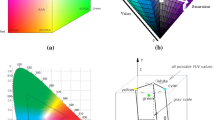Abstract
While human skin is relatively easy to detect in controlled environments, detection in uncontrolled settings such as in consumer digital photographs is generally hard. Algorithms need to robustly deal with variations in lighting, color resolution, and imaging noise. This paper proposes a simple generative skin patch model combining shape and color information. The model is parametric and represents the spatial arrangement of skin pixels as compact elliptical regions. Its parameters are estimated by maximizing the mutual information between the model-generated skin pixel distribution and the distribution of skin color as observed in the image. The core of this work is an empirical evaluation on a database of 653 consumer digital photographs. In addition, we investigate the potential of combining our skin detector with state-of-the-art appearance-based face detectors.
Access this chapter
Tax calculation will be finalised at checkout
Purchases are for personal use only
Preview
Unable to display preview. Download preview PDF.
Similar content being viewed by others
References
Christopher M. Bishop, editor. Neural Networks for Pattern Recognition. Oxford University Press, 1995.
A. Colmenzrez and T. Huang. Face detection with informationbased maximum discrimination. In CVPR, pages 782–787, 1997., 1997.
G.D. Finlayson, B.V. Funt, and K. Barnard. Color constancy under varying illumination. In ICCV’95, pages 720–725, 1995.
Margaret M. Fleck, David A. Forsyth, and Chris Bregler. Finding naked people. In ECCV (2), pages 593–602, 1996.
Hideo Fukamachi Jean-Christophe Terrillon, Mahdad Shirazi and Shigeru Akamatsu. Skin chrominance models and chrominance spaces for the automatic detection of human faces in color images. In Proceedings of the Fourth IEEE International Conference on Automatic Face and Gesture Recognition, March 2000.
Michael J. Jones and James M. Rehg. Statistical color models with application to skin detection. In CVPR, pages 274–280, 1999.
H. Rowley, S. Baluja, and T. Kanade. Neural network-based face detection. PAMI, 20(1):23–38, 1998.
D. Roy and A. Pentland. Learning words from natural audio-visual input. In International Conference of Spoken Language Processing, December 1998.
H. Schneiderman and T. Kanade. A statistical method for 3d object detection applied to faces and cars. In CVPR, June 2000.
Leonid Sigal and Stan Sclaroff. Estimation and prediction of evolving color distributions for skin segmentation under varying illumination. In CVPR, 2000.
T. Starner and A. Pentland. Real-time american sign language recognition from video using hidden markov models. In SCV95, page 5B Systems and Applications, 1995.
Moritz Stoerring, Hans J. Andersen, and Erik Granum. Skin colour detection under changing lighting conditions. In 7th International Symposium on Intelligent Robotic Systems’99, pages 187–195, July 1999.
James Ze Wang, Jia Li, Gio Wiederhold, and Oscar Firschein. System for screening objectionable images using daubechies’ wavelets. In International Workshop on Interactiv Distributed Multimedia Systems and Telecommunication Services, pages 20–30, 1997.
W.M. Wells III, P. Viola, H. Atsumi, S. Nakajima, and R. Kikinis. Multi-modal volume registration by maximization of mutual information. Medical Image Analysis, 1(1):35–52, march 1996.
Christopher Richard Wren, Ali Azarbayejani, Trevor Darrell, and Alex Pentland. Pfinder: Real-time tracking of the human body. PAMI, 19(7):780–785, 1997.
Ming-Hsuan Yang, David Kriegman, and Narendra Ahuja. Detecting faces in images: A survey. PAMI, 24(1):34–58, January 2002.
Author information
Authors and Affiliations
Editor information
Editors and Affiliations
Rights and permissions
Copyright information
© 2002 Springer-Verlag Berlin Heidelberg
About this paper
Cite this paper
Kruppa, H., Bauer, M.A., Schiele, B. (2002). Skin Patch Detection in Real-World Images. In: Van Gool, L. (eds) Pattern Recognition. DAGM 2002. Lecture Notes in Computer Science, vol 2449. Springer, Berlin, Heidelberg. https://doi.org/10.1007/3-540-45783-6_14
Download citation
DOI: https://doi.org/10.1007/3-540-45783-6_14
Published:
Publisher Name: Springer, Berlin, Heidelberg
Print ISBN: 978-3-540-44209-7
Online ISBN: 978-3-540-45783-1
eBook Packages: Springer Book Archive




